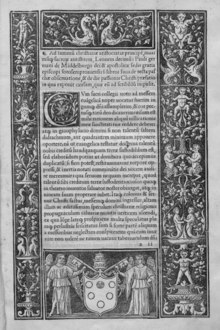Paul of Middelburg
Paul von Middelburg (* 1445 in Middelburg ; † December 13, 1534 in Rome ) was a Dutch scholar and from 1494 until the end of his life a Roman Catholic Bishop of Fossombrone (today the diocese of Fano-Fossombrone-Cagli-Pergola ) in the province of Pesaro and Urbino , a suffragan from Urbino ( Archdiocese of Urbino-Urbania-Sant'Angelo in Vado ).
Life
Paul came from Middelburg in the Netherlands, a family name is unknown, an Italian source named him Paolo di Adriano . His godchild Julius Caesar Scaliger called him "Omnium sui sæculi mathematicorum ... facile princeps" (Prince of the mathematicians of his century).
After studying in Leuven , he got a job as a canonicus in Middelburg , but lost it again, after which he complained about his homeland ("barbara Zelandiæ insula", "vervecum patria", "cerdonum regio").
He went to Italy, taught in Padua (1480), and became a doctor of Francesco Maria I della Rovere , the Duke of Urbino , a relative of Sixtus IV and a friend of the later Emperor Maximilian I. In 1488 he got the Benedictine abbey San Cristoforo in Casteldurante . With Pope Alexander VI. he was recommended for the diocese of Fossombrone , which he received in 1494. He then destroyed some of his earlier works: Giudizio dell 'anno 1480 , in which he attacked some mathematicians; Practica de pravis Constellationibus , and Invectiva in superstitiosum Vatem . He chose a coat of arms with astronomical motifs and expanded or beautified the bishop's palace in 1497. Paul died in Rome and was buried in S. Maria dell 'Anima.
Calendar reform
Paul was court astrologist at Federico da Montefeltro and wrote works on the necessary calendar reform. He was then invited by Popes Julius II and Leo X to the Fifth Lateran Council (1512–1518) (see Aloisius Lilius ) and appointed head of the department for calendar reform. In this role, Paul not only made his own proposals for calendar reform, but also ensured that Pope Leo X and Emperor Maximilian I obtained further opinions from other scholars. These scholars selected by Paul included Georg Tannstetter and Andreas Stiborius , the mathematicians of the Collegium poetarum et mathematicorum in Vienna . In order to maintain the correct length of the year in the long term, they suggested omitting a leap day every 134 years (as in their proposal from the end of 1514, which was printed soon afterwards). Also Johannes Stoeffler of Tuebingen was asked.
Nicolaus Copernicus was invited to the council by Paul himself in 1513, but was probably not present in person (his answer has not been recorded). Nevertheless, Copernicus was probably commissioned in the course of the 5th Lateran Council to determine the planetary orbits and shortly afterwards (around 1515) began work on his main work " De Revolutionibus " (he had already disseminated the basic idea in a handwritten form earlier, probably in 1509 Book outlined, called Commentariolus ).
So Paul had initiated the professional discourse on the calendar issue; the 5th Lateran Council had not remained completely ineffective with regard to the planned calendar reform.
In his main work Paulina, de recta Paschae celebratione from 1513, Paul first deals in great detail with the reform proposals of his predecessors such as Marcus Vigerius, Nicolaus Cusanus and Pierre d'Ailly . He then turned against skipping several days in such a way that the beginning of spring fell again on March 21st (just as one actually missed 10 days later when the Gregorian calendar was introduced ). He was in favor of the beginning of spring (on which the calculation of Easter depends) should still be on March 10th. In addition, instead of the previous 7, only 5 leap months ( embolismic months ) should be inserted in a 19-year lunar cycle .
Paul's suggestions would not have changed the basic problems of the calendar calculation, namely that 19 solar years do not correspond to exactly 235 lunar months. The difference would still have accumulated every 134 years to a day's deviation from the spring equinox and every 304 years to a day's deviation from the time of the full moon.
Works
- Epistola ad Universitatem Lovaniensem de Paschate recte observando (1487)
- Epistola apologetica (1488)
- Paulina, de recta Paschae celebratione (Fossombrone, 1513).
literature
- Friedrich Karl Ginzel : Handbook of mathematical and technical chronology. Timekeeping of the Nations . Leipzig 1906. Volume 2, § 253.
- Siegmund Günther : Paulus von Middelburg . In: Allgemeine Deutsche Biographie (ADB). Volume 25, Duncker & Humblot, Leipzig 1887, p. 248.
- Ferdinand Kaltenbrunner: The prehistory of the Gregorian calendar reform . Vienna 1876.
- Ernst Zinner: Origin and Spread of the Copernican Teaching . Munich 1988.
Web links
- Paul von Middelburg Catholic Encyclopedia . New York: Robert Appleton Company. 1913.
Individual evidence
- ↑ Gaetano Moroni: Dizionario di erudizione storico-ecclesiastica , vol. XLIV, Venice 1847, p. 120, digitized
- ↑ Gaetano Moroni: Dizionario di erudizione storico-ecclesiastica , vol. LXXXV, Venice 1857, p. 314, digitized
- ↑ See Franz Graf-Stuhlhofer : Humanism Between Court and University. Georg Tannstetter (Collimitius) and his scientific environment in Vienna in the early 16th century . Vienna 1996, pp. 125–128.
| personal data | |
|---|---|
| SURNAME | Paul of Middelburg |
| ALTERNATIVE NAMES | Paulus Middelburgensis; Paulus Forosemproniensis; Paul of Middelburg |
| BRIEF DESCRIPTION | Roman Catholic scientist and Bishop of Fossombrone (from 1494) |
| DATE OF BIRTH | 1445 |
| PLACE OF BIRTH | Middelburg |
| DATE OF DEATH | December 13, 1534 |
| Place of death | Rome |
